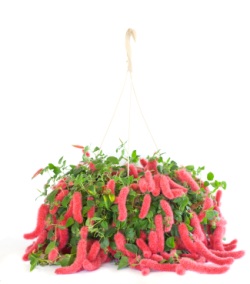





Botanical Name: Acalypha pendula
Dwarf Chenille Plant gets its common name from the fuzzy plumes of tiny red flowers that trail above a thick mound of small, serrated leaves. Given enough light, this plant blooms nearly year-round.
Place this unusual house plant on a pedestal stand or pot it in a hanging basket to show off those eye-catching fuzzy blooms.
This is a dwarf variety that stays small and doesn't need pruning. It's naturally bushy, so you don't have to pinch its growing tips to get it to branch out.
Shed some light. Bright light is essential to getting this plant to bloom.
It blooms most heavily summer through fall. If it doesn't bloom much, move it to where it will get direct morning sun and/or indirect afternoon sun from a south- or west-facing window.
Deadheading tip: Pinch off flowers as soon as they start to fade. This will encourage many more blooms.
Keep it well-watered and fertilized during the growing season. This plant also appreciates high humidity. You can place the pot on a tray of wet pebbles to raise the humidity around it. Or, mist the foliage with room-temperature water every day except when the plant is in bloom.
Raising the humidity also helps to prevent spider mites from invading. Watch out for these pests, especially in winter when indoor air tends to get dry.
Repot in spring only when it has outgrown its container. Use a pot with drainage holes to prevent soggy soil.
I can understand why Dwarf Chenille Plant would appeal to cats, who may be tempted to play with its tassel-like blooms. However this member of the Euphorbia family is known for its poisonous plants, so it's a good idea to keep it away from pets.

Origin: Java and New Guinea
Height: Up to 1 ft (30 cm)
Light: Bright indirect light in summer; 4 hours direct sun per day in winter.
Water: Keep soil evenly moist. Do not let it dry out completely.
Humidity: Moderate to high humidity. Take a look at these ways to raise the humidity for your plant.
Temperature: Average to warm 65-85°F, 18-29°C
Soil: Any good potting mix.
Fertilizer: Feed every 2 weeks spring and summer with a high-phosphorus liquid fertilizer diluted by half.
Propagation: Easy to propagate from stem cuttings. Take 3 in (8 cm) stem cuttings in spring and root in equal parts all-purpose potting mix and perlite.
Copyright © www.100flowers.win Botanic Garden All Rights Reserved